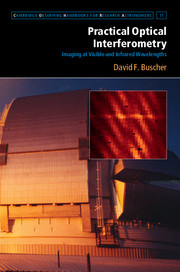Book contents
- Frontmatter
- Contents
- Principal symbols, functions and operators
- List of abbreviations
- Foreword
- Preface
- 1 Making fringes
- 2 Basic imaging
- 3 Atmospheric seeing and its amelioration
- 4 Interferometers in practice
- 5 Measurement noise
- 6 Interferometric observation of faint objects
- 7 Observation planning
- 8 Data reduction
- 9 Model fitting and image reconstruction
- Appendix A Fourier transforms
- Appendix B Supplementary online material
- References
- Index
Appendix B - Supplementary online material
Published online by Cambridge University Press: 05 August 2015
- Frontmatter
- Contents
- Principal symbols, functions and operators
- List of abbreviations
- Foreword
- Preface
- 1 Making fringes
- 2 Basic imaging
- 3 Atmospheric seeing and its amelioration
- 4 Interferometers in practice
- 5 Measurement noise
- 6 Interferometric observation of faint objects
- 7 Observation planning
- 8 Data reduction
- 9 Model fitting and image reconstruction
- Appendix A Fourier transforms
- Appendix B Supplementary online material
- References
- Index
Summary
In a rapidly changing field such as interferometry, a static item like a book quickly goes out of date. To supplement the material in this book, some material has been placed online and can be accessed at the URL http://www. cambridge.org/9781107042179.
The online material includes links to other online material such as websites for the major interferometry projects and sites providing interferometry software.
It also includes additional tools based on the material presented in the book. Although many of the figures in this book have been taken from the literature, many had to be prepared from scratch or reworked into a format suitable for presentation in this book. The graphs were prepared using the programming language Python, using its numerical libraries Numpy and SciPy, together with the Matplotlib plotting library. The source code for these plotting programs, together with the graphical results, have been made available as part of the online material.
It is hoped that these will form a valuable technical and educational resource in themselves. In some cases, readers may want to know the exact values that were used in a given graph. Instead of taking a ruler to the graph, they can print out the values with a small modification to the relevant plotting program. In other cases, the reader may want to compare or s the results from different graphs and, as the software has been written in a relatively modular fashion, this should be straightforward. Access to the source code of the programs should also allow the techniques used in the preparation of the data to be studied in detail and employed elsewhere.
Included in this software is a simple interferometer simulation framework. This includes an atmospheric wavefront perturbation generator of the type described in Section 3.5.2, a means of correcting the perturbations with a simple adaptive optics system and a means of measuring the fringe parameters of spatially filtered and unfiltered fringes. This could be extended in many ways to derive new results and I encourage people to experiment with it.
- Type
- Chapter
- Information
- Practical Optical InterferometryImaging at Visible and Infrared Wavelengths, pp. 255 - 256Publisher: Cambridge University PressPrint publication year: 2015



